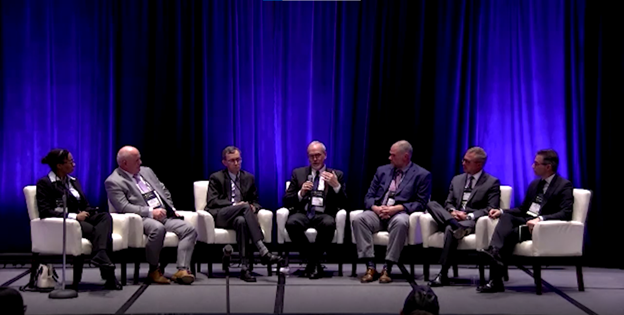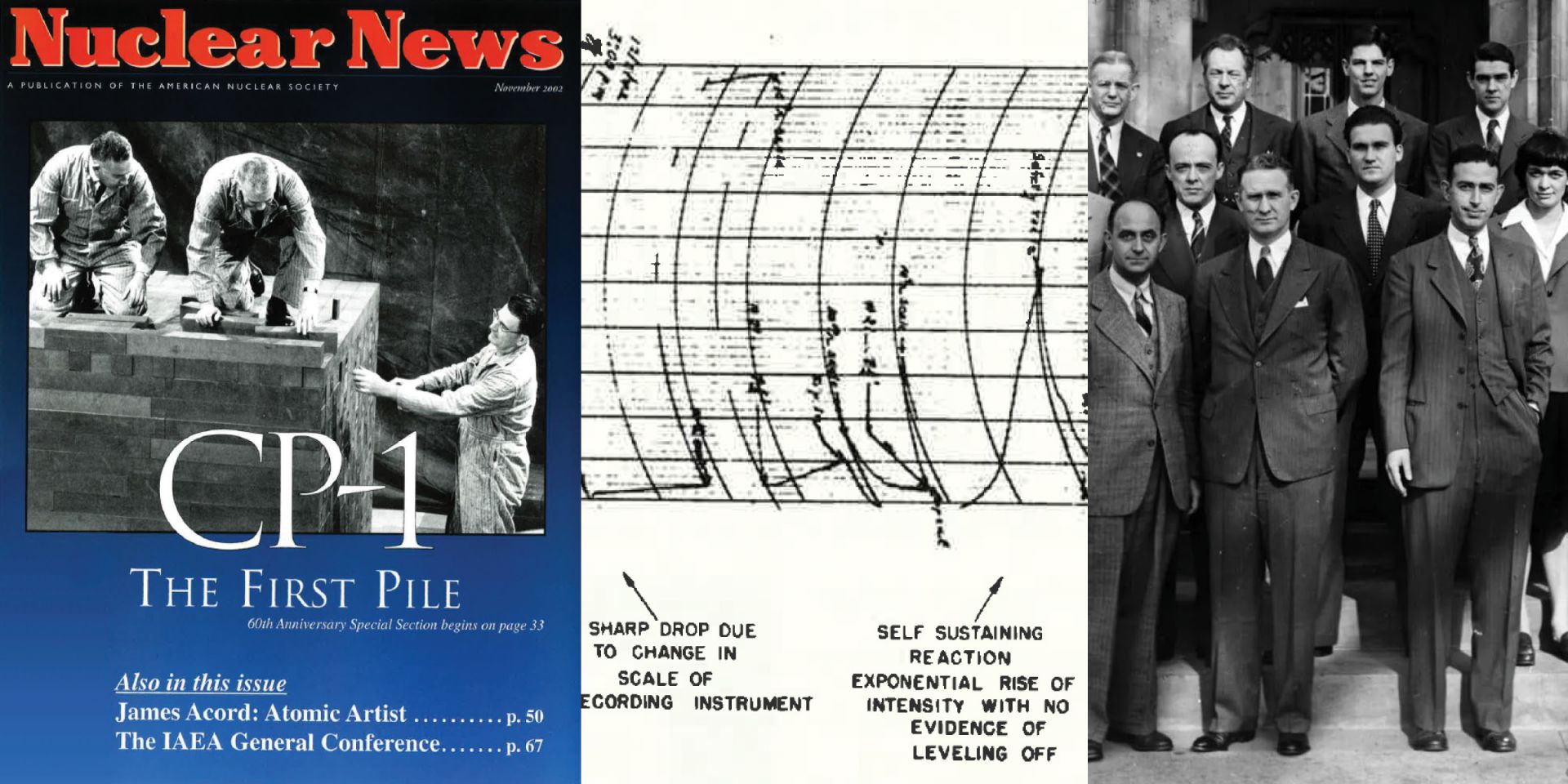Workers walk down a passageway in Panel 8 at the Waste Isolation Pilot Plant in November. (Photo: DOE)
Employees have begun emplacing defense-related transuranic (TRU) waste in Panel 8 of the Waste Isolation Pilot Plant (WIPP) in New Mexico, the Department of Energy’s Office of Environmental Management (EM) announced in November. TRU waste is permanently disposed of at WIPP in rooms mined in a Permian salt bed 2,150 feet below the surface.
From left: Christina Leggett (Booz Allen Hamilton), Morris Hassler (IB3 Global Solutions), Everett Redmond (Oklo), Andy Griffith (DOE-NE), Ben Jordan (Centrus), Stephen Long (GLE), and Magnus Mori (Urenco).
Whether commercial demand for high-assay low-enriched uranium (HALEU) fuel ultimately falls at the high or low end of divergent forecasts, one thing is certain: the United States is not ready to meet demand, because it currently has no domestic HALEU enrichment capacity. But conversations happening now could help build the commercial HALEU enrichment infrastructure needed to support advanced reactor deployments. At the 2022 American Nuclear Society Winter Meeting, representatives from three potential HALEU enrichers, the government, and industry met to discuss their timelines and challenges during “Got Fuel? Progress Toward Establishing a Domestic US HALEU Supply,” a November 15 executive session cosponsored by the Nuclear Nonproliferation Policy Division and the Fuel Cycle and Waste Management Division.
On December 2, 1942, a group of 49 scientists led by Enrico Fermi created the world’s first controlled, self-sustaining nuclear chain reaction underneath the University of Chicago’s Stagg Field football stadium. Some of those present went on to found Argonne National Laboratory. (Image: Argonne)
At a moment of global crisis, in a windowless squash court below the football stadium bleachers at the University of Chicago, a group of scientists changed the world forever.
On December 2, 1942, a team of researchers led by Enrico Fermi, an Italian refugee, successfully achieved the world’s first human-created, self-sustaining nuclear chain reaction. Racing to beat Nazi Germany to the creation of an atomic weapon, the team of researchers, working as part of the Manhattan Project, split uranium atoms contained within a large graphite pile—Chicago Pile-1, the first nuclear reactor ever built.
Westinghouse employee completing visual inspection of I&C part
Obsolescence and the ability to obtain qualified replacement and spare parts are primary concerns in the nuclear industry. In fact, approximately 35% of installed equipment is obsolete.
Westinghouse Parts Business (WPB) has over 50 years of experience replacing and upgrading systems for operating nuclear power plants with access to original design information as the original equipment manufacturer (OEM).
WPB provides innovative, cost-efficient solutions for Westinghouse and non-Westinghouse systems in order to increase reliability of I&C systems, including enhanced replacement components, repair and refurbishment services. Recently, WPB has supported numerous customers in obsolescence and Reverse Engineering (RE) services.
The Yakutia awaits launch at St. Petersburg’s Baltic Shipyard on Nov. 22. (Photo: TASS/Valentin Yegorshin)
Advancing its efforts to develop the Arctic and establish new energy markets, Russia launched a new nuclear-powered icebreaker, the Yakutia, in St. Petersburg during a November 22 ceremony. At the launching in the northern Russian port city, the Russian flag was raised on another nuclear icebreaker, the Ural. Overseeing the events via video link from the Kremlin, Russian president Vladimir Putin said that the icebreakers “were laid down as part of a large serial project and are part of our large-scale, systematic work to reequip and replenish the domestic icebreaker fleet, to strengthen Russia's status as a great Arctic power.”
The JET tokamak. (Photo: European Consortium for the Development)
Nuclear fusion “might actually be on the cusp of commercial viability” today, says a recent article in Fortune magazine. The article offers a brief review of recent technical and entrepreneurial developments in fusion energy. It also places these developments in perspective regarding the hurdles that remain before commercialization can be realized.
Philippine president Ferdinand R. Marcos Jr. and Vice President Harris meet in Manila on November 21. (Photo: Office of the Press Secretary, Republic of the Philippines)
During a recent weeklong trip to Southeast Asia aimed at bolstering U.S. economic and security ties in the region, Vice President Kamala Harris announced the launch of nuclear energy partnerships with Thailand and the Philippines.
Currently, neither country enjoys the benefits of nuclear power. Both rely primarily on some mix of petroleum, natural gas, and coal for their energy needs.
Diagram of the University of Rochester Laboratory for Laser Energetics’ OMEGA laser system. (Image: University of Rochester)
A study recently published in Nature Communications brings a new perspective on how radiation travels through dense plasmas, potentially leading to a better understanding of the evolution of stars and the development of controlled nuclear fusion reactions. Researchers led by investigators at the University of Rochester Laboratory for Laser Energetics (LLE) achieved their findings by conducting experiments with LLE’s OMEGA laser system. This extensive system, which is 19 meters tall and 70 meters long, consists of 60 laser beams that can focus as much as 30,000 joules of energy onto a target for the study of nuclear and fluid dynamic events.
A room full of displays at the Art of the Reactor exhibit. (Photo: IIT)
Nuclear power plant cooling towers are easily recognizable for their familiar hyperboloid shape. But an art exhibit running at the Illinois Institute of Technology in Chicago aims to give visitors a different perspective.
The Art of the Reactor, an exhibit by the National Museum of Nuclear Science and History and hosted by IIT’s Lewis College of Science and Letters, opened on November 4 and runs until Sunday, December 4 at Hermann Hall on the IIT campus.
Tarik Choho, Westinghouse nuclear fuel president (left, foreground), and Simon-Erik Ollus, executive vice president of Fortum Generation, shake hands after signing the VVER-440 fuel contract, surrounded by Fortum and Westinghouse team members. (Photo: Westinghouse)
Westinghouse Electric Company and Finnish energy company Fortum have jointly announced the signing of a long-term partnership to develop, license, and supply VVER-440 fuel to Finland’s two-unit Loviisa nuclear power plant.
The ARE building at ORNL. (Photo: ORNL)
Experimentation on the world’s first molten salt reactor to potentially power aircraft was already underway in November 1954, being carried out by the U.S. Air Force. Oak Ridge National Laboratory was the scene for the power-dense, high-temperature reactor experiment known as the Aircraft Reactor Experiment (ARE).



















